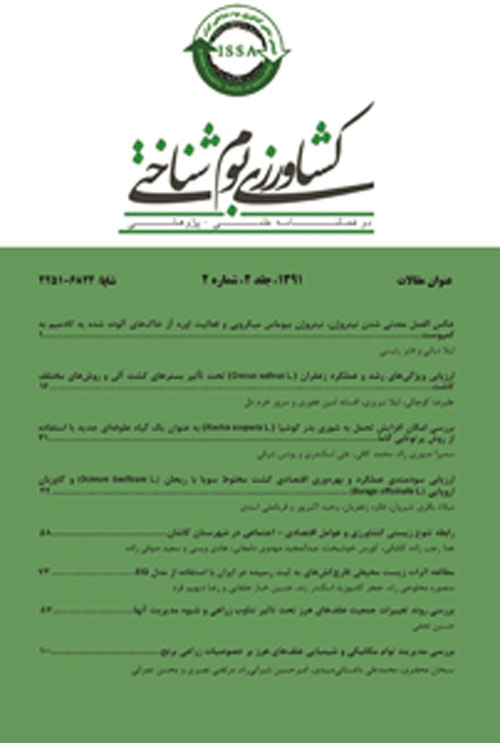A performance assessment of the agroecosystem of forage maize under different tillage methods and crop residue management
Author(s):
Abstract:
Introduction
Conservative agriculture with minimal adverse effects on the environment has been the subject of great interest recently as a means of promoting sustainable crop production and food security (Nkala etal., 2011). The approach is practiced in large-scale commercial agriculture. Conservative agriculture also encourages the optimal utilization of resources such as soil and water and helps the sustainability of products in the agroecosystem (Stavi etal., 2016). Nonetheless, due to the diversity of conservation farming operations around the world, it is critical to prioritize different tillage methods according to cultivation conditions and climatic conditions (Miller et al., 2012). The main objective of this study was i) to assess the efficacy of different conservative soil tillage (minimum and/or zero tillage) in combination with crop residue and fertilizer management in achieving maximum crop production; and ii) to assess the effects of management practices on agroecosystem performance using agronomic and environmental data and scoring function descriptions.Materials And Methods
To achieve the goals, a field experiment was carried out involving 7 treatments with varying combinations of different tillage methods, crop residues and fertilizer management on a field of maize which was planted after the cultivation of a wheat crop. At the end of the growing season, the chemical and physical soil properties as well as the total yield of corn were measured. The physical and chemical parameters measured in the soil included electrical conductivity, field capacity, available water, porosity, pH, soil organic carbon, total crop biomass and maize yield. Agroecosystem performance was assessed using a computer program entitled the AgroEcosystem Performance Assessment Tool (AEPAT). It utilizes performance-based index methodology to derive a relative ranking of agroecosystem performance among management practices for functions and indicators included in the procedure. Data measured by the software AEPAT are rated from 0-100 to calculate two agroecosystem functions including conservation agriculture and food production.Results And Discussion
The results showed that stalk chopper瘫崴 kg N-fertilizer瘫岅 treatment resulted in the maximum amounts for field capacity (25.63%), available water (15.63%), porosity (49.2%) and organic carbon (0.73%). The highest total biomass (87.3 th-1) and ear yield (23.8 tha-1) was also obtained using this treatment. In contrast, the lowest amounts for these parameters were obtained with the stubble burning disc ditcher treatment. This was due to the stubble burning which increased the soil electrical conductivity and reduced the physical and chemical soil quality. On the other hand, leaving the on-farm residue in place plays an important role in regulating electrical conductivity and soil salinity. It can be concluded that the type of agriculture practiced affects the soil physicochemical properties to a high extent. Leaving crop residue in the field may increase the soil biological activity resulting in soil porosity and aggregation. The analysis on sustainability of agricultural practices showed that stalk chopper瘫崴 kg N-fertilizer瘫岅 treatment had the highest score for agroecosystem performance (61.21) in terms of both optimum yield and sustainability. The lowest score of 7.63 was obtained with stubble burning瘫᳹�爗 treatment.Conclusion
In conclusion, it was demonstrated that conservative tillage in combination with crop residue not only led to a higher maize yield but also improved the soil quality. Nonetheless, for conservative tillage to be effective adequate N-fertilizer, as a starter to provide needed crop growth nutrients, must be applied. In addition, the efficiency of the indexing score is critical in discriminating between different agricultural practices within and across agroecosystem functions. The agricultural practices had a direct effect on agroecosystem performance and the soil physicochemical properties can be used as an index to assess agroecosystem function and performance.Keywords:
Language:
Persian
Published:
Journal of Agroecology, Volume:7 Issue: 1, 2017
Page:
1
magiran.com/p1733786
دانلود و مطالعه متن این مقاله با یکی از روشهای زیر امکان پذیر است:
اشتراک شخصی
با عضویت و پرداخت آنلاین حق اشتراک یکساله به مبلغ 1,390,000ريال میتوانید 70 عنوان مطلب دانلود کنید!
اشتراک سازمانی
به کتابخانه دانشگاه یا محل کار خود پیشنهاد کنید تا اشتراک سازمانی این پایگاه را برای دسترسی نامحدود همه کاربران به متن مطالب تهیه نمایند!
توجه!
- حق عضویت دریافتی صرف حمایت از نشریات عضو و نگهداری، تکمیل و توسعه مگیران میشود.
- پرداخت حق اشتراک و دانلود مقالات اجازه بازنشر آن در سایر رسانههای چاپی و دیجیتال را به کاربر نمیدهد.
In order to view content subscription is required
Personal subscription
Subscribe magiran.com for 70 € euros via PayPal and download 70 articles during a year.
Organization subscription
Please contact us to subscribe your university or library for unlimited access!


